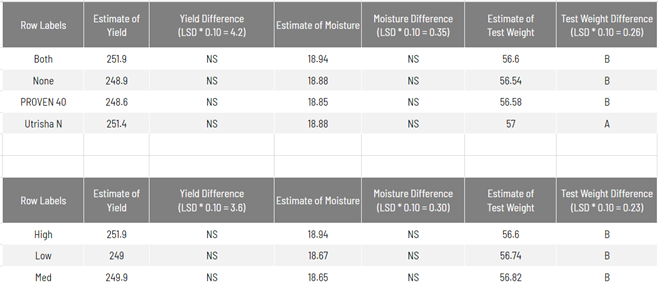2023 PAR (Product & Agronomy Research) Report: Corn Nitrogen and Utrisha® N
BY Dairyland Seed Agronomy Team
Description:
The use of biological products in crop production is becoming a common practice in many operations. Utrisha® N is a microbe, Methylobacterium symbioticum, that is applied foliar to the corn plant at V5. Utrisha N colonizes the above-ground portion of the corn plant through the stomata and lives off byproducts of photosynthesis. In return, Utrisha N fixes nitrogen from the atmosphere and makes it available to the corn plant. We tested Utrisha N with total nitrogen rates ranging from 80 lbs. to 230 lbs. per acre and compared those results with the untreated check.
Wabash, IN:
- Planting date May 18
- Hybrid: DS-5095AM
- Study was replicated
- All treatments planted with 40 lbs. of nitrogen
- Nitrogen rates adjusted to treatment totals at sidedress
- Utrisha N applied at V5 (5 oz/A)
Treatments:
- 80 units of N
- 140 units of N
- 170 units of N
- 200 units of N
- 230 units of N
- 80 units of N + Utrisha N
- 140 units of N + Utrisha N
- 170 units of N+ Utrisha N
- 200 units of N + Utrisha N
- 230 units of N +Utrisha N
St. Johns, MI:
- Planting date May 6
- Hybrid: DS-3900AM
- Study was replicated
- All treatments received: 300 lbs/A Potash + 125 lbs/A MAP DBC (Fall); 5 gal/A Pro-Germinator + 4 gal/A Sure-K + 0.50 gal/A Micro 500 + 0.25 gal/A Mn + 0.25 gal/A eNhance (IF); 15 gal/A 28% (Conceal)
- Nitrogen rates adjusted to treatment totals at side dress
- Utrisha N applied at V5 (5 oz/A)
Treatments:
- 180 units of N
- 135 units of N
- 175 units of N
- 80 units of N + Utrisha N
- 135 units of N + Utrisha N
- 175 units of N+ Utrisha N
Results:
2023 Wabash, IN Results

2023 St. Johns, MI Results

2022 Wabash and St. Johns Results

Conclusion:
There was no significant difference in moisture or test weight for either location this year. At both Wabash and St. Johns, the Utrisha® N applied with 80 total pounds of nitrogen resulted in the highest advantage. Other Utrisha N treatments at Wabash did not show an advantage, which suggests that nitrogen was not the most limiting factor to yield. By reducing the total pounds of nitrogen to 80 units, we forced nitrogen to become the limiting factor. This allowed the plant to capitalize on nitrogen being fixed by the bacteria in Utrisha N.
Last year’s results showed no significant difference in yield for either Wabash or St. Johns. The lowest total nitrogen rates used last year were 135 pounds for Wabash and 170 pounds for St. Johns. We concluded that nitrogen was not the most limiting yield factor and noted how even the lower nitrogen rates did not yield significantly less than the higher nitrogen rates. This suggested that products like Utrisha N were capable of insuring yield in reduced nitrogen scenarios. By lowering the total nitrogen ranges this year for St. Johns, we were able to make nitrogen a yield limiting factor. This resulted in positive advantages with Utrisha N for each nitrogen range. Each year is different and presents its own set of challenges, but the yield results we are seeing with reduced nitrogen rates is very encouraging.

Brian Weller
Western Region
507.456.3034

Rod Moran
Western Region
507.456.3034

Dan Ritter
Central Region
219.863.0583

Branden Furseth
Northern Region
608.513.4265

Mark Gibson
Eastern Region
260.330.8968

Amanda Goffnett
Eastern Region
989.400.3793

Ryan Mueller
Eastern Region
989.400.3793
